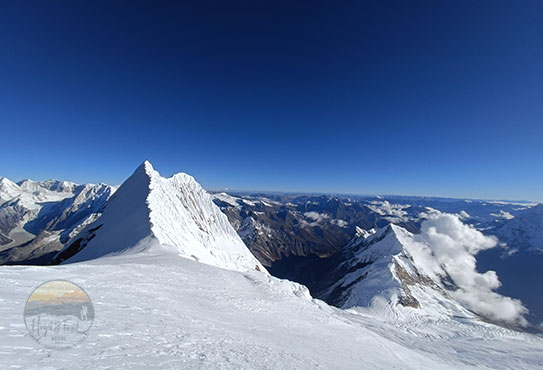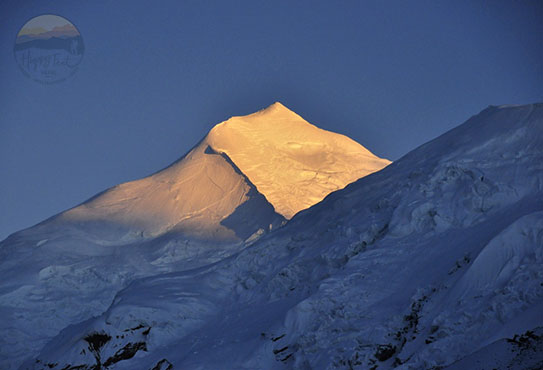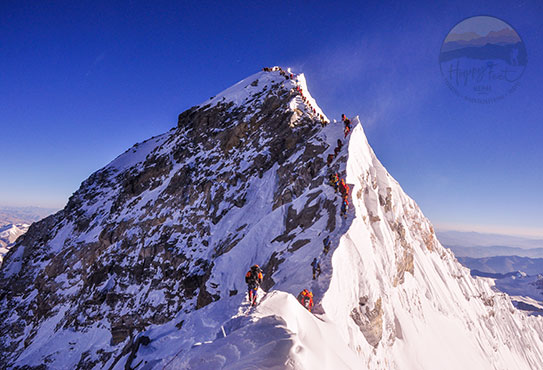Sunday - Friday: 9 AM - 4 PM
Ama Dablam Expedition is one of the fame-filled climbing activities. The Ama Dablam Himal is a beautiful mountain in the Himalayas range. Its height is medium, 7000 meters, and the technical aspect of mountaineering is high, so it is a unique mountain for those who want to enjoy mountaineering. Those who climb the Ama Dablam may climb Mt. Everest, but climbing a medium 8,000-meter mountain secures Everest’s success rate and self-security.
Mount Ama Dablam, with a height of 6,812 metres, is the most beautiful mountain in the Himalayan range of eastern Nepal. Ama Dablam’s name comes from the Sherpa dialect, meaning mother’s Necklace. The World knows the region as Mount Everest Region, but Mount Ama Dablam is its dominant mountain due to its exposure above the valley to the east of Khumbu. This mountain is the third most popular Himalayan peak for permitted expeditions. Many climbers love to test their technical climbing skills on it because of its mix of steep rock and ice along the climbing route, high above the broad valley of Tengboche. The standard climbing route is along its southwest Ridge, requiring three camps above basecamp.
This beautiful mountain was first climbed on 13 March 1961 by Mike Gill (NZ), Barry Bishop (USA), Mike Ward (UK) and Wally Romanes (NZ) via the Southwest Ridge as part of the Silver Hunt Scientific Expedition of 1960-61, led by Sir Edmund Hillary. The journey to base camp starts with a short panoramic flight to Lukla. After that, the Ama Dablam basecamp reaches over a six-day acclimatizing trek through villages of the Sherpas of the Khumbu region.
On the way to Ama Dablam Base Camp, stop at Pangboche Village, one of the ancient villages in the Khumbu Valley and visit its monastery, which also houses the Yeti’s Skull, and pray for all members’ peaceful and safe expedition. We also request a puja ritual from the Monks at the monastery to solicit the local deities for an obstacle-free expedition and continue walking up to basecamp. The final Puja ceremony gets celebrated for all expedition members and equipment taking on the mountain at the AmaDablam basecamp.
Once the puja is performed, the climbing Sherpa guides begin transporting the equipment, high-altitude food, and other supplies to the higher camps. The climbing members accompany them to advanced camps, camps one and two, for acclimatizing climb. After a week or so of acclimatizing, the ascent to the summit begins following routine procedures. The summit attempt initiates from camp two, but a possible camp is probably set at camp three, at the Dablam.
Arrive in Kathmandu, customs and immigration formalities and claim your baggage, which takes some time. Upon exiting, the arrivals get a traditional welcome from the Happy Feet Nepal representative and transfer to the hotel. Reach the hotel and the rest of the day is free with the possibility of optional excursions (not included), but you can ask to organize any tours or stroll through its vibrant streets.
Kathmandu, the capital and heart of the country, with three medieval cities, symbolizes Nepal’s everything. Having lived through the several ruling dynasties of Buddhists and Hindus, the culture and society of Kathmandu Valley have evolved through time to give it more than a unique feature. Today it is an urban city, and still rapidly increasing, that has its ancient myths and, at the same time, is testimony to the greatness of people who have lived there for time immemorial.
A completely free day to do last-minute shopping and repacking the bags to basecamp properly. This evening you will need to hand over your bags to Basecamp for cargo to Lukla and then by porter to Everest base camp. The mountaineering team leader will need to go to the Department of the Ministry of Tourism to sign the document related to the mountaineering permit and responsibilities.
A 30-minute flight and a 3-hour trek.
Breakfast and take a short drive to Kathmandu Airport to board the domestic flight to Lukla. A morning flight of 40 minutes takes us to Lukla, with grand views of Himalayan peaks. We will be greeted with an excellent mountain in the panorama from the first step to the Lukla airport, with cool air letting you feel the atmosphere. We spend about an hour with tea/coffee and handover our luggage to the porters. Then, we take a short introductory walk while the porters prepare their load. After spending an hour, we start the trek with great excitement.
Star trek through the village of Lukla, gets checked with Khumbu Pasang Lhamu and TIMS permits at the end of the town and exits from the village with immediate walking down through a forest facing northwest with welcoming views of Mount Kongde (DudhKunda Mountains) in front. After about twenty minutes walk, the trail traverses to Chhoplung, seeing the village and School of Chauri Kharka (currently misspelt with Chaula Kharka). (Chauri is female Yak, and Kharka means Shed in Nepali), the largest and ancestral village of Lukla village until Lukla Airport was sheepherders pastureland. After a short traverse, we join the trail from Jiri to Everest Basecamp at Chhoplung, a hamlet of Sherpas. From Chhoplung, there is a level trail with short descending and climbing and traverses several villages, including Ghat. The views in front are Phakdingma, the Dudh Kosi River Valley and Kongde Mountain. Most houses on the trail and villages are lodges and restaurants for travellers. Finally, we cross several beautiful villages, such as Ghat and arrive at Kharikhola village on the bank of the Dudh Koshi River.
A 5-hour Trek.
The trek follows the Dudh Koshi River valley through a narrow valley gorged by the Dudh Koshi River and guarded by Kusumkangru Mountain and Kongde Mountain bases. The river valley becomes narrower but a pleasant walk with occasional mountain views and teahouse until we approach Monjo, the entrance point of Sagarmatha National Park and our lunch place, a lovely place on the bank of Dudh Kosi River. The high mountain slopes are beautifully dense, home to elusive Himalayan fauna and flora.
The afternoon walk takes uphill to Namche Bazaar through a lovely forest, crossing the Dudh Kosi twice through a sky-soaring suspension bridge. The walking up to Namche takes 2 hours with rest.
Namche Bazar lies at an altitude of 3500 metres, and it is one of the main junctions, branching trails to Thame, Khumjung and Tengboche. The path via Thame leads to Tibet via Nangpa La Pass, to Rolwaling via TashiLapcha Pass and to Gokyo via Renjo La. With the demand of the time, the Sherpa town has developed itself as a colourful and divergent market, selling everything, including trekking and mountaineering equipment. In addition, there are hotels, restaurants, pubs, cybercafé, pool houses, Banks, health posts, a monastery, and a Sherpa house museum. Most trekkers take a rest day at Namche while hiking up and take a lunch or refreshment stop while returning. Those taking a rest at Namche can take a hike to Thamo village on the way to Thame or stroll at Everest View Hotel, a five-star hotel above Namche with fantastic views of Everest and its surroundings.
After breakfast, we make a scenic Namche to Khumjung trek. The trail leads through the Shayngboche airstrip, a short landing field for the Pilatus Porter plane. Instead of going directly to Khumjung, we take the trail via Everest View, a 5-star hotel, enjoying the 360-degree panorama surrounding the Khumbu region. Probably lunch at Everest View Hotel and take a leisurely descent to Khumjung. If we go to Khumjung for Lunch, we visit Khunde village and its monastery.
A 4-hour Trek.
A scenic trail exits to the northeast of Khumjung with a gradual descending and reaches a trail junction branching to Gokyo, Namche, Khumjung and Tengboche. We take the trail to Tengboche, traversing a hill ridge. The DudhKosi valley, Thamserku, Kusum Kangru, Ama Dablam, Lhotse, Nuptse, Everest, Tawoche, Khumbila and Kongde are some of the highlights of the day. The area from Namche to Tengboche and Phortse is home to the Himalayan tahr, standing on the sheer cliff tops and hill slopes with luxurious manes and rainbowy impean pheasants, the national bird of Nepal, and skittery Musk Deer. We take the trail to Everest base camp and head toward the PhortseTenga with a pleasant descent, where we take our lunch below the Phortse and Tengboche villages.
The afternoon requires uphill till Tengboche through a forest full of rhododendron, pine and birch. While resting, the views toward Namche with Kongde, Everest view hotel, Mongla, Kangthega, Kusumkangru, Dudh Kosi Valley, and Khumbila are beautifully open. With the first step on the Tengboche meadow, the views to the north are unobstructed, with an imposing Mount Ama Dablam, Lhotse, and Nuptse topped by the tip of Mount Everest. Tengboche is a beautiful place in terms of its views. Get checked into the rooms and refreshments, and visit the Tengboche Monastery.
Tengboche Monastery is one of the most known monasteries in Nepal, probably because of its unrivalled backdrop of Mt. Ama Dablam. This monastery was the leading Buddhist centre in the Khumbu region under the guidance of Tengboche Rinpoche, who passed away on 10 October 2020. Another active monastery in the Khumbu region is the Thame Monastery. But among the most ancient are Pangboche Monastery, Thame Monastery and Rimijung Monastery, founded by the Lama SangwaDorjee and his two tantric brothers.
An acclimatizing day at Tengboche. Visit the monastery, rest and hike high above northeast of Tengboche monastery. The area is dense with rhododendron bushes and offers fine views of Ama Dablam and Khumjung, Namche and Tengboche.
A 3-hour trek.
The morning starts with grand views in front. The first part of the trek leads downhill through a lovely rhododendron and pine forest to Diboche, with several lodges and a monastery of nuns; those interested may visit the monastery. Continuing a level walk through a pleasant and primitive-looking forest brings us below the Pangboche village. Next, we cross the bridge and go uphill to Pangboche with a majestic view of Ama Dablam; the base camp of Ama Dablam is barely within two hours of easy walking distance, but we spend the overnight in Pangboche.
The ancient original settlement is located above the main trail to Everest Base Camp amidst tall Himalayan juniper trees, so we shortly climb the village and visit the Pangboche village, one of the ancient villages of Khumbu valley with a monastery. Amongst the three most ancient monasteries in Khumbu Valley are Pangboche Monastery, Thame Monastery and Rimijung Monastery, founded by the Lama SangwaDorjee and his two tantric brothers. We arrive here for lunch, so check into a lodge, have lunch and visit the village.
After breakfast, we visit the Pangboche village and 400 years old monastery, the oldest in the region. After the visit, we take a beautiful short trek to the Ama Dablam base camp. Finally, reach the base camp for lunch. Our kitchen crew, climbing Sherpa guides and liaison officer will greet us. Our tents will be ready before our arrival, so check into the tent assigned for you. After lunch, we will briefly meet about the rest of the program.
The group stays at basecamp for two days for resting, meeting, and the final puja ceremony for all expedition members, guides, Sherpa climbing guides, and all climbing equipment carried on the mountain. A monk from the Pangboche village gets invited for a puja ritual to solicit the local deities for a peaceful and obstacle-free expedition.
A 6-hour Trek.
We descend to Pangbcohe village and take lunch. After lunch, we’ll set off for Phortse village, a beautiful village of Sherpa people. Tourists frequent less this part of the trail, so the chances of seeing wildlife and birdlife are high. From Phortse or the entire trail offer views of Ama Dablam, Tengboche, Kusumkangru, Khumbila, Khumjung, Kongde, and Dudh Koshi Valley. Phortse village has a monastery and a mountaineering school, and it is opposite the west of Tengboche meadow and can view each other from them. From Phortse, there are trails to Gokyo, Tengboche, Pangboche and Khumjung.
Stop at Phortse for a refreshing drink and continue the trek. Cross the river from Gokyo Valley, fed by Ngozumba glacier, which merges with the river from Khumbu glacier at Pungi Tenga, where we took lunch while going to Tengboche. A short walk reaches a junction to Gokyo and Namche/Khumjung, and the trail traverses a narrow valley with a steep climb to Mongla. Mongla is a small hill ridge with a stupa, some teahouses and an extraordinary view, including Tengboche and Phortse villages, Everest view hotel, and the uncountable mountains in the row in a few kilometres across the valley.
A 5-hour Trek.
Breakfast with amazing sceneries and a short downhill to Khumjung village, the Khumbu region’s main ancient village, composed of the Khumjung and Khunde. And accordingly, the villages have two monasteries, a school, a hospital, several hotels and lodges. On the way, visit the Khumbu monastery, walk up to Khunde village, rest with some refreshments, and see the villages. Then leave the Khunde village and walk southwest, cross a mani-wall and stupa, and a beautiful gradual hike through sparse but tall pine trees and fantastic Himalayan sceneries, including Khunde village and Khumbila. Khumbila is the sacred black mountain above Khumjung and Khunde villages, with several ancient meditation caves. Finally, arrive at a lovely ridge opening to the southwest with views of Kongde and a small Pilatus potter landing field. Cross the landing field and see the entire Namche bazaar under our knees and the huge Dudh Kosi valley with countless rolling hills, and the mountain sceneries are always there. A short descent at Namche, have rest and lunch. After lunch, we retrace the trail down to Monjo, a pleasant two-hour walk.
A 6-hour Trek.
The last day of the trek! The trail retraces through all those tiny hamlets of Sherpa people along the Dudh Kosi river valley until Chhoplung but with different views and perspectives. From Chhoplung, we take the trail to Lukla, which requires a short uphill through a thin forest above the Chaurikharka village. Arrive at Lukla and get checked into a lodge. Trekking is over with a great sense of accomplishment. The evening is an occasion to celebrate to see off to your porters who accompanied you until here. The porters will travel separately to Kathmandu with one long day walk to Kharikhola and another full day drive to Kathmandu or start another trek to Everest basecamp!
A 30-minute flight.
Most flights get operated early in the morning, so we must wake up early. Take an early breakfast while the guide and porters transport your bags to the airport, take a short walk to Tenzing-Hillary airport, get checked in and fly to Kathmandu. A short scenic flight takes you to Kathmandu. Upon landing, the representative of Happy Feet Nepal will welcome you back and transfer you to your hotel. Get distributed to the rooms, and the rest of the day is free.
The expedition team leader must visit the tourism ministry to sign the related document. Other members are free to do their last-day activities. The evening gets dedicated to a farewell dinner in one of the celebrative restaurants of Kathmandu.
Breakfast and the rest of the day are leisure on your own. The Representative of Happy Feet Nepal will arrive at your hotel with transport three hours before your departure flight time. Get escorted from the hotel to the International Departure Terminal, see off formalities, and go through the immigration and departure.



